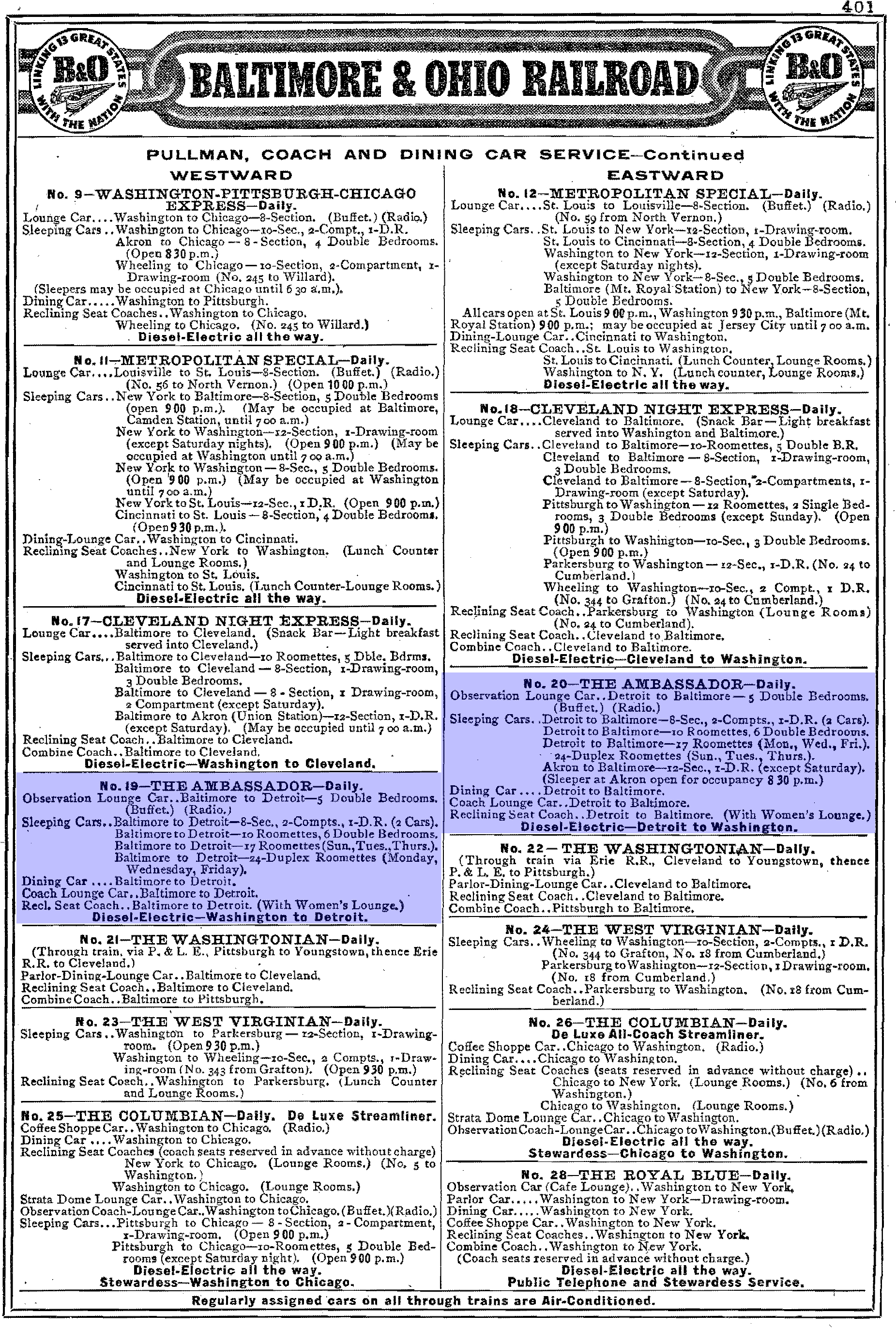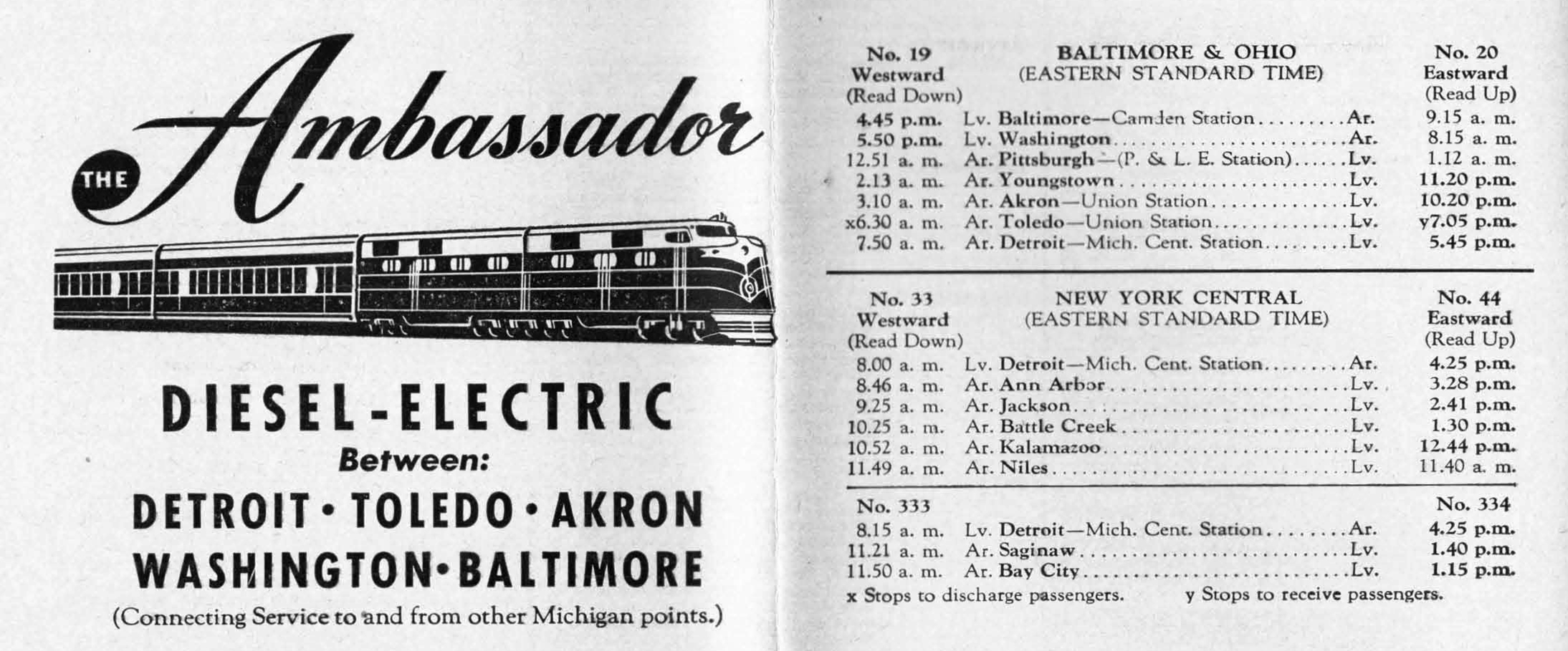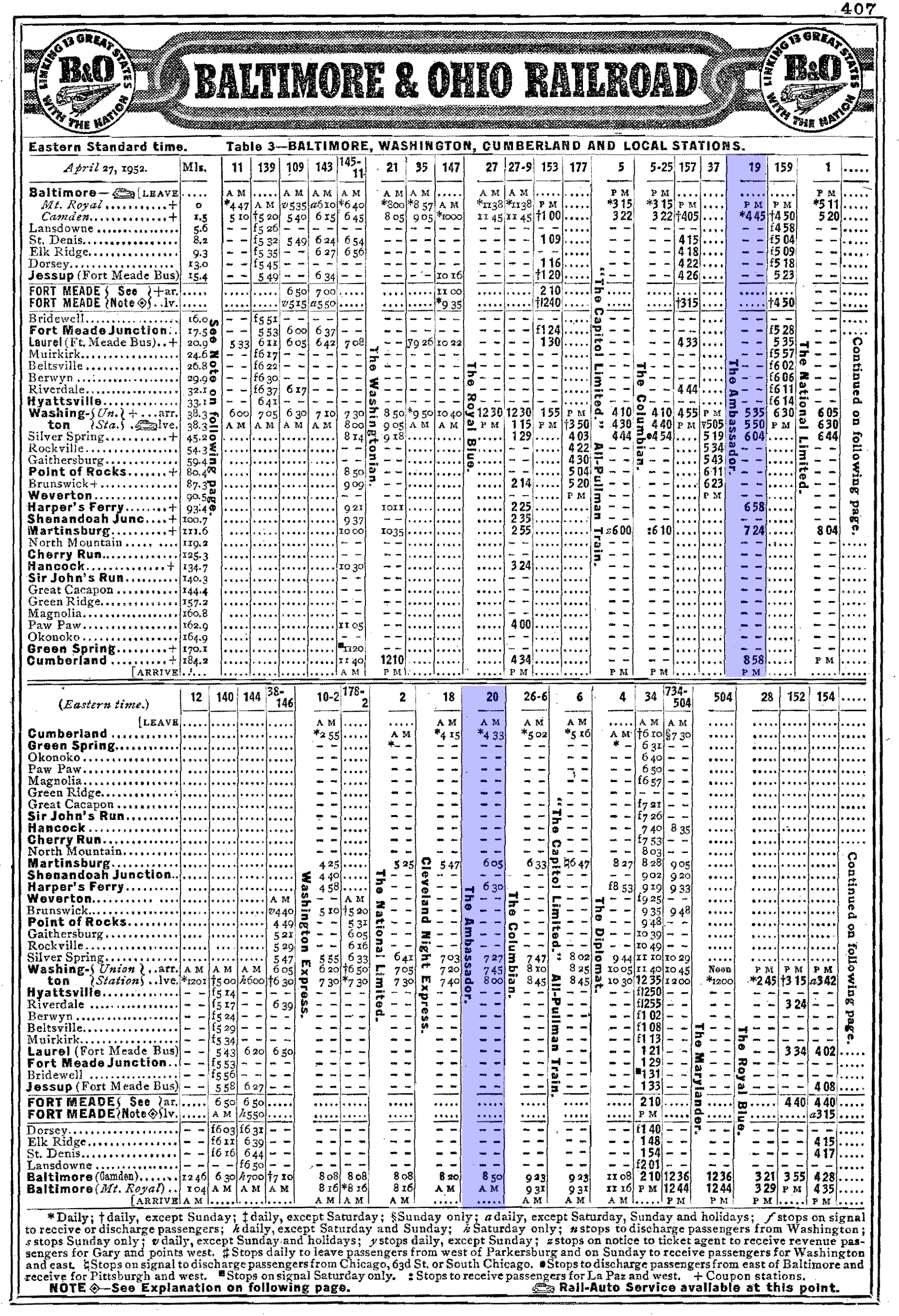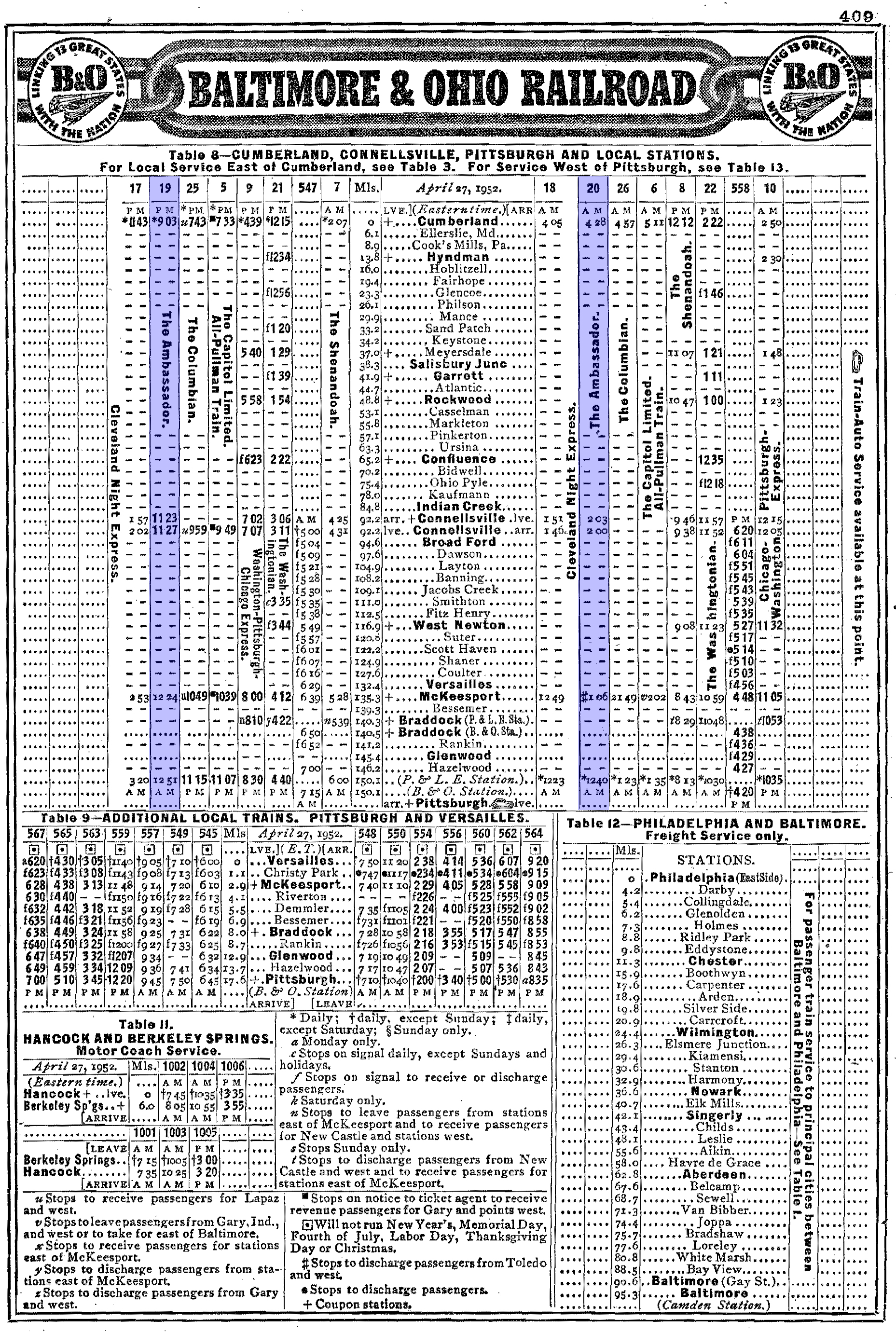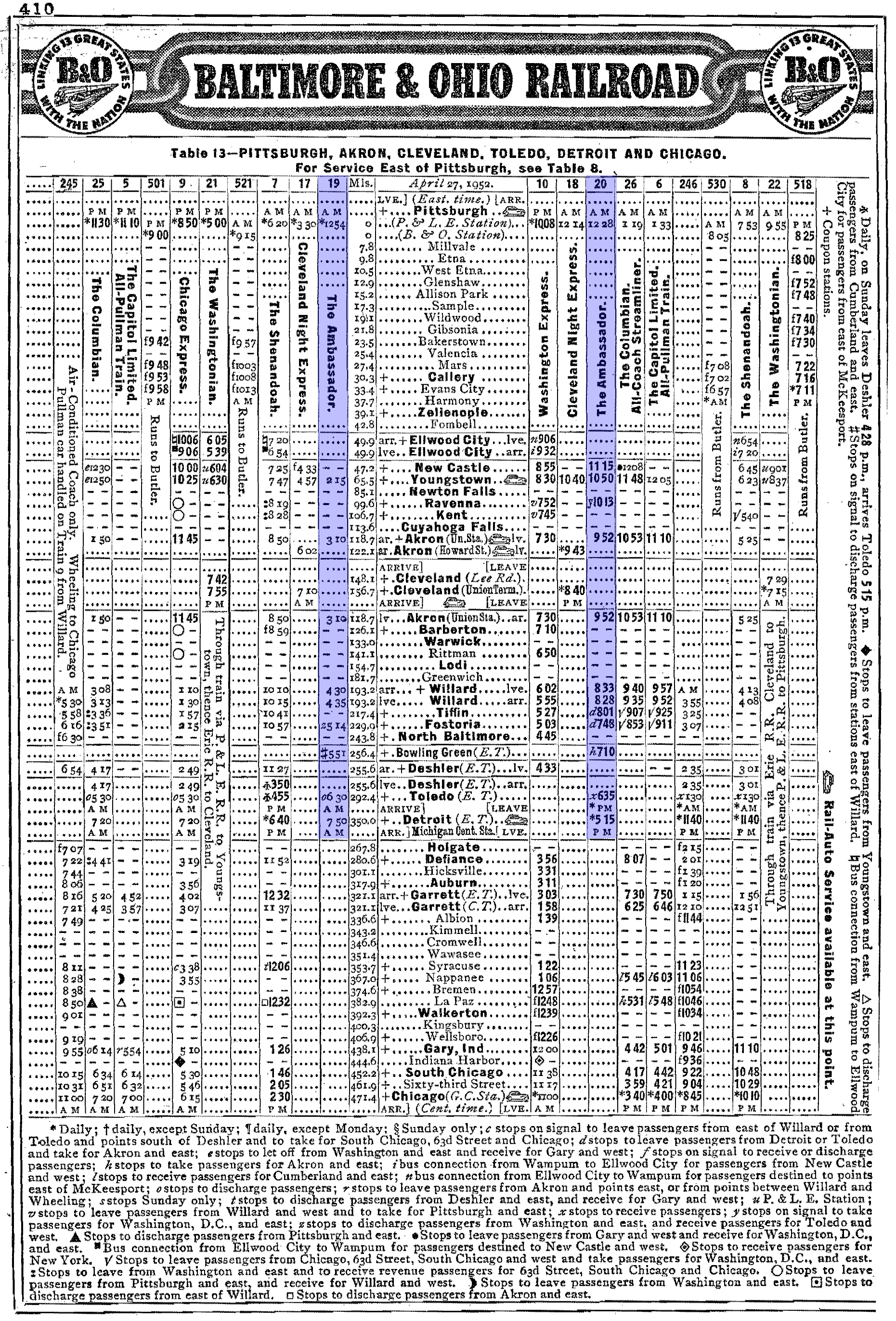B&O's "Ambassador" (Train): Route, Consist, Timetable
Last revised: February 25, 2025
By: Adam Burns
Operating along its Baltimore/Washington, D.C.-Detroit corridor, the Baltimore & Ohio considered the Ambassador one of its premier and most important trains, behind only the Capitol Limited and National Limited.
It regularly carried notable clientele during its peak years and continued to see a high patronage far beyond World War II. However, as the public abandoned trains for automobiles and airlines into the 1950s the B&O began cutting back services.
Interestingly, despite its status as a first-tier train, the Ambassador would not see 1965. It was ultimately combined with other trains and quietly disappeared from the timetable.
History
The first appearance of the name Ambassador on B&O's timetable occurred in the spring of 1930 when it replaced the railroad's former Detroit-Washington Limited/Washington-Detroit Limited (westbound train #19, eastbound #20) that had only been in service itself since June of 1925.
As one of the B&O's premier trains the Ambassador was one of the first to tout air-conditioning in 1932 via a heavyweight diner, and before World War II the entire train boasted this luxury.
At the time such a first-class accommodation was an entirely new technology and rarely found in public places let alone private homes.
Aside from a full dining car, the rest of the train's consist then included a baggage-coach, reclining-seat coaches, a standard lounge, several sleepers, and a lounge-observation (all heavyweight equipment). It also carried some head-end, mail and express.
Passengers could also enjoy other first-rate amenities such as valet service (for Pullman customers), a stewardess-nurse who tended to any need, a maid manicurist for the ladies, and a secretary for the gentlemen.
Consist (1952)
While the train saw a high patronage throughout the war, the B&O officially marketed the Ambassador towards business clientele and automobile executives traveling to and from Washington, D.C. for government-related affairs.
This was not considerably surprising since Detroit at the time was a booming metropolis and widely regarded as the automobile capital of the world. The train's status earned it top priority, enabling it to make the trip in just over 15 hours, departing Baltimore at 4:45 P.M. and arriving in the Motor City the next morning at 7:50 A.M.
Streamlined Equipment
During April, 1946 the train changed its Detroit terminal, switching from Fort Street Union Depot to New York Central's Michigan Central Station. This move sliced an additional 15 minutes from the schedule.
After World War II the B&O upgraded its remaining top trains that were not already streamlined via either new equipment, overhauling older heavyweight cars, or purchasing surplus lightweight cars from other roads.
At the time the Ambassador also remained steam powered using the railroad's handsome Presidential class 4-6-2 Pacifics.
However, by the end of the decade the train sported streamlining and diesels (E6As/Bs). Thanks to its continued popularity during the early 1950s it also received its first lightweight cars at that time in the form of two observation cars, Dana and Metcalf.
1948 Advertisement
Newer and more powerful diesels also followed in the form of E7s and E8s. Despite the train's high ridership through the Korean War the B&O was forced to cutback its passenger fleet by the mid-1950s as patronage slipped, coupled with the railroad's increasingly weak financial state.
After January 10, 1954 the railroad combined the Ambassador and Columbian (Washington/Baltimore - New York - Chicago) between Washington and Willard, Ohio on an occasional basis but also continued running each train independently when spikes in traffic warranted such.
Timetable (1952)
After the B&O gave up the New York market to the Pennsylvania during late April of 1958 it combined the Ambassador, Columbian, and Capitol Limited permanently between Baltimore and D.C.
It is rather incredible, in comparison to some of the B&O's other trains, how quickly the Ambassador declined. The train was one of the railroad's most popular and important during the early 1950s but within a decade became merely a section of the Columbian (after 1961).
Timetable (July, 1963)
(By this date the train was only a section of the Capitol Limited between Willard and Detroit.)
| Read Down Time/Leave (Train #5/Capitol Limited) | Milepost | Location | Read Up Time/Arrive (Train #6/Capitol Limited) |
|---|---|---|---|
| 3:50 PM (Dp) | 0.0 | 11:05 AM (Ar) | |
| 4:35 PM (Ar) | 36.8 | 10:25 AM (Dp) | |
| 5:00 PM (Dp) | 36.8 | 10:00 AM (Ar) | |
| 5:14 PM | 43.7 | 9:39 AM | |
| 6:05 PM | 91.9 | ||
| 6:33 PM | 110.1 | 8:20 AM | |
| 8:05 PM (Ar) | 182.7 | 6:45 AM (Dp) | |
| 8:13 PM (Dp) | 182.7 | 6:38 AM (Ar) | |
| 10:35 PM (Ar) | 274.9 | 4:08 AM (Dp) | |
| 10:38 PM (Dp) | 274.9 | 4:05 AM (Ar) | |
| 11:35 PM | 317.9 | F 3:02 AM | |
| 12:00 AM (Ar) | 332.7 | 2:35 AM (Dp) | |
| 12:17 AM (Dp) | 332.7 | 2:32 AM (Ar) | |
| 1:23 AM | 379.9 | 1:25 AM | |
| 1:47 AM | 398.2 | 1:02 AM | |
| 2:51 AM | 452.0 | 12:04 AM | |
| 3:00 AM (Ar) | 525.9 | 9:55 PM (Dp) | |
| Time/Leave (Train #19/Ambassador) | Milepost | Location | Time/Arrive (Train #20/Ambassador) |
| 3:30 AM (Dp) | 525.9 | 9:30 PM (Ar) | |
| F 3:55 AM | 550.1 | F 9:04 PM | |
| F 4:15 AM | 562.6 | F 8:53 PM | |
| F 5:00 AM | 589.1 | F 8:16 PM | |
| 5:55 AM | 625.1 | 7:40 PM | |
| 7:25 AM (Ar) | 682.7 | 6:15 PM (Dp) |
Final Years
At this time its consist included merely a coach, sleeper, and sleeper-lounge and all of the luxuries it once offered had been abolished. In 1964 the name disappeared altogether from timetable with its remaining equipment picked up by the Capitol Limited.
The railroad continued to serve Detroit but did so via far less fanfare and a slower schedule under the Cincinnatian. This train had once been a highly publicized streamliner as well, serving the Baltimore/D.C.-Cincinnati market beginning in the late 1940s.
However, lack of ridership on the sparsely populated route shifted it to the Detroit-Cincinnati corridor where it remained until the start of Amtrak during the spring of 1971.
Sources
- Reynolds, Kirk and Oroszi, David. Baltimore & Ohio Railroad. Osceola: MBI Publishing, 2000.
- Schafer, Mike and Welsh, Joe. Streamliners, History of a Railroad Icon. St. Paul: MBI Publishing, 2003.
- Welsh, Joe. Baltimore & Ohio's Capitol Limited And National Limited. St. Paul: MBI Publishing, 2007.
Contents
Recent Articles
-
Alabama Christmas Train Rides In Silverhill!
Dec 18, 25 04:02 PM
Perhaps the best-known among the Wales West RV Park & Light Railway's excursions is the Arctic Express, a Christmas-themed train ride that has become a cherished holiday tradition for families alo… -
Wisconsin Christmas Train Rides In Wisconsin Dells!
Dec 18, 25 04:01 PM
Part railroad museum, part working shop, and part scenic excursion, the little Riverside & Great Northern Railway has become a beloved outing in the Dells—especially when its Santa Trains bring Ch… -
Ohio Christmas Train Rides In Lebanon!
Dec 18, 25 09:49 AM
Of all the Lebanon Mason Monroe Railroad's seasonal offerings, none is more celebrated than the North Pole Express, a holiday tradition that draws thousands of guests each Christmas season.

